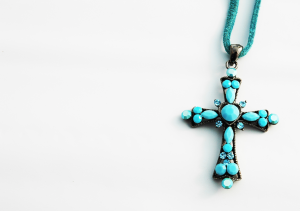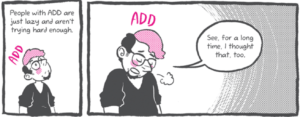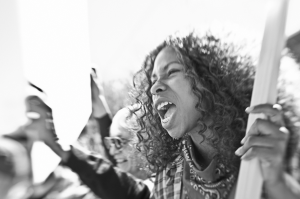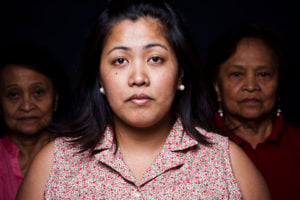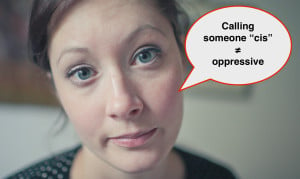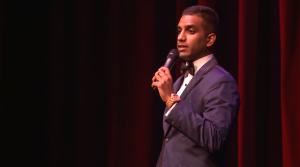
Source: Confront Depression
Originally published on The Militant Baker and cross-posted here with their permission.
If I had to pinpoint the thing that influenced my body positivism the most, it wouldn’t be a role model. It wouldn’t be a feminist magazine. It wouldn’t be supportive friends. It wouldn’t even be writing here on The Militant Baker.
All of those things help and create the strong force that keeps me going, but there was one pivotal turning point for me. One thing that changed it all: history.
I thrive on facts. They speak to me. I trust in them. If you can prove why something is, I can use that information to better my life. Body image is one of those subjects, and I’m about to school you in a way you’ve never been schooled before. HISTORY LESSON TIME!
I acknowledge the clusterfuck of a society that we live in right now. I acknowledge the inequality, the bias, the misfortune of all minorities.
I see and fight bigotry on a daily basis, but I’ve always wanted to know why.
Why is our structure this way? Why are women singled out for body shame? Why are fat people bullied to the point of suicide? Why have we learned to hate ourselves? How did we get here?
Allow me to enlighten you.
This “why” comes from several moments that are complicated and muddy. There is nothing simple about our sordid, oppressive, and money-driven past. I can’t include all the information in one post, but I’ll cover the basics and dissect it into digestible pieces for clarity’s sake; hang with with me while I do so.
Our body image issues come from three major points in history, two of which are specific to the United States. The body issues that we see internationally also stem from US-specific history; our idea of perfection was cultivated here and then transplanted abroad. Europe has its own interesting story line, but the problem is largely from North America.
Let’s begin.
1. Farming and the Development of Patriarchy
Women lost equality and any hope of a balanced future the moment humans decided to stop the hunter-gatherer lifestyle and become farmers.
Up until that point, hunter gathers lived in a “matriarchal society,” which didn’t necessarily mean that women had the upper hand, but that the group responsibilities relied heavily on the female gender. Women nurtured, took care of, fed, and kept the community connected.
Men’s priorities focused on hunting and fertilization. Food was never stored in large quantities simply because the group was always moving, and it’s interesting to note that because of this constant travel, women had children four years apart. They would wait until the youngest could walk before having another child that needed to be carried.
But once stationary life started, everything changed.
Farmers could all of a sudden store excessive amounts of food, which allowed survival even through difficult seasons. With survival being the ultimate need, those with more food became the superior citizens, and thus, economic class systems were born.
Suddenly, crops were of paramount concern, and each family wanted more farmers; more farmers = more food = more wealth. Women became “farmer making machines” and desired property for husbands. Virginity became a desirable trait (“Don’t give away my workers to anyone else!”), and patriarchy was soon interwoven into the growing society.
This left women with a distinct disadvantage and is the reason we have gender injustice today. Interwoven patriarchy is the cause of the female targeting that we see in the next two sections. (Read more here.)
2. The Slenderization for Class Distinction
In the late 1800s, obesity was actually a sought-after body type in the United States. At the time, tuberculous and other diseases were causing people to waste away; body fat was a healthy and enviable trait.
Additionally, food was scarce and survival was again of utmost importance. The wealthy were distinguished by their heavier body types, and this highlighted their obvious access to a plethora of food.
But all of this shifted as meals became readily available.
Middle- and lower-class citizens began to fill out, and soon, the “rich folk” blended in with the rest. Add the sudden influx of migrant workers whose heavier body type tended to be stocky, and classes were no longer distinguishable.
The privileged decided to have none of it. Intake control and weight loss was of utmost importance, and when slim, the aristocrats became recognizable once again. Thus, we began the fight for a superior body image.
It’s important to realize that “obesity” was never a concern for physicians during this time. The “obesity parasite,” as it was called, was started by a few overweight and wealthy men who decided that fat was repulsive. Publications with this unfounded propaganda began to spread, and the middle class began to agree that large bodies were a social tragedy.
The Obesity Crisis was created by the people.
Doctors didn’t originally participate in creating the obesity myth, though as the popularity grew, they promoted the idea due to the collective pressure. (Read more here and here.)
3. Perfection As an Economic Life Raft
The last piece of this puzzle was centered around World War II.
Previous to this historical event, the US economy was singularly floated by the houseware industry. Housewives had the spending power, and domestic life was all the rage.
However, when the men left for war, the women were needed in the factories. And this was the game changer.
When the men returned and resumed work, women were sent back to the home, fully aware of their capabilities and potential independence. No longer satisfied with in-home submission, the domestic industry started to tank.
I would imagine that the influx of cute 50s ads that we all adore was a last ditch attempt to sell what was no longer flying off the shelves. But it was an epic fail.
Because of the unexpected economic quicksand, advertisers (the vast majority being men; remember the creation of patriarchy?) scrambled to find another money-making industry. And so they chose two concepts that would always be: beauty and age.
They created an impossible standard — a flawless woman who has never existed, and they presented her as the one and only desirable goal.
It’s a brilliant and effective business plan that continues today; women will forever attempt to purchase perfection. Perfection that will always be out of reach.
Profitable yes, but it comes at a cost for the human race. (Read more here.)
***
If we look at these puzzle pieces, we can see the obvious incentive: money. Money and power, which translates into survival — in its purest form. Our history revolves around the fear of extinction.
This is the root of all of our problematic behaviors today.
Hatred in any form stems from this primitive terror, but unlike the original homo sapiens (hunters) who needed fear to survive dangerous circumstances, we have evolved to the point where our panic is misguided and used incorrectly.
Fear can be a healthy response and is necessary for some forms of survival; we do inherently have fight or flight for a reason. But our hatred (which is fundamentally fear) of bodies that look different is learned. It’s a scheme that was created by wealthy men in smoke-filled offices over 50 years ago.
Allow me to ask you this: Are you going to let your value as a human decrease because of a businessman who is no longer alive? Are you going to base your decisions on how you live your life on a profit scheme? Are you going to hate yourself for not living up to a standard that does not exist? Lord, help us all.
Ladies. Let’s not torture ourselves any longer. Let’s not miss out on a life that can be full of joy, beauty, happiness, and fulfillment because of a historical construct. You deserve better than that; I deserve better than that. We all deserve to live in a world where these lies are exposed, old myths are debunked, and all conspiracies are unraveled. A world full of truth and acceptance.
We have one life. One body. This is all we have.
So live that life! Love that body! And be the best you that you can possibly be. This is all we have. And it is enough.
You, my dear, you are enough.
[do_widget id=”text-101″]
Jes Baker is a mental health professional, pastry chef, and fat model. She is internationally recognized for her writing on her blog, The Militant Baker, the “Attractive and Fat” campaign, and her dedication to shifting social paradigms into a place where all people are offered the opportunity to love themselves just as they are. Follow her on Twitter @militant_baker.
Search our 3000+ articles!
Read our articles about:
Our online racial justice training
Used by hundreds of universities, non-profits, and businesses.
Click to learn more





